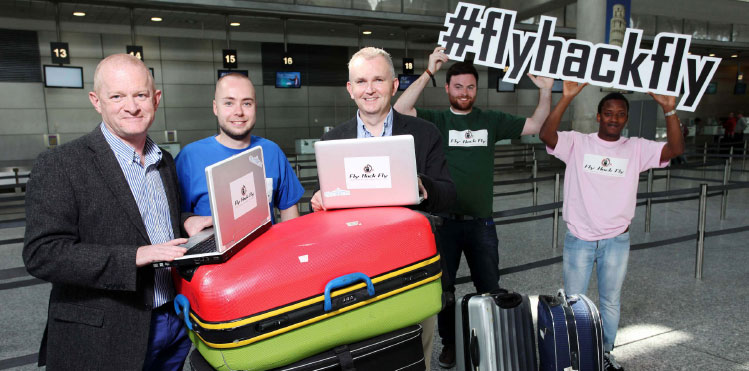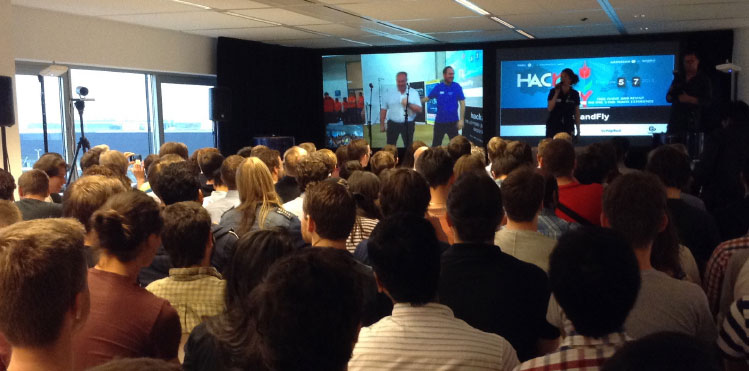Hackathons have become the ‘must have’ in various streams of work and life in general – with a number of European airports allowing themselves to become caught up by the wave in recent months. They sound quite technical and even geeky. For many the word just prompts more questions. What and who does it involve? What are they trying to do? Is it legal? How useful is a hackathon and what is the outcome the participants are working towards? Robert O’Meara reports.
The word ‘Hackathon’ has a curious quality – it manages to sound both dangerous and yet simultaneously community-driven, but what does it really entail? The origins of ‘hacking’ come from the activities of computer coding experts who sought (and indeed still seek) to break down walls and access important, useful or secret information from another person, company or institution. In that context, the practice was/is illegal – however, the verb ‘hacking’ has, over time, broadened and acquired a positive meaning as well.
Type the words ‘Top 10 hacks’ or ‘life hacks’ into the internet search engine of your choice and you’ll be amazed by the amount of free advice on offer, aiming at improving your life through simple tips and solutions. Similarly, if you add the word ‘hack’ to an internet search about everything from career management to personal finance, or from fashion to romantic entanglement, you will see just how much ‘hacking’ now goes well beyond the sphere of information technology, computers and geeks. Once people have a good idea, which simplifies or makes some aspect of life more efficient, then they share it online.
In truth, today ‘hacking’ is as much about the cultural concept of breaking down barriers, as it is about computer coding. For companies, it’s about accessing and exchanging information which may previously have been in silos, and solving problems using out-of-the-box thinking. It has also retained another key original characteristic – the urgency of an intense deadline within which to find solutions. Or to put it another way, all hackathons are a race against time.

Pictured at the launch of Cork Airport’s #flyhackfly hackathon were Fergus Murphy, CEO of Plus10, Blaine Doyle, glowdx.com, Kevin Cullinane, Head of Communications at Cork Airport, Will Martin, liveduel.com, and Philip Mngadi, foundersmarket.com. The event, a first for an Irish airport, took place at Cork Airport over the 2nd and 3rd October 2015 as part of the Startup Gathering. The event was open to developers, designers and marketers.
Inspiration from Silicon Valley
Among the big name brands, Facebook is the perhaps the most celebrated advocate of ‘hackathons’. It holds hackathons on a monthly basis, at which new ideas are born, people from different teams and departments intermingle and exchange ideas. This allows information and cooperation to circulate, and improves both internal communication and the ‘team’ culture of the company – and all in the space of 48 hours. For the participants, these hackathons are an opportunity to unleash their creativity in the fun atmosphere of an all-nighter, where the-clock-is-ticking and the fuel of choice is Chinese food (a tradition dating back to Facebook’s days as a humble start-up). Such has been the success of these events, that very quickly other companies – including other giants such as Google, Apple and others started holding their own hackathons.
So what about airports?
As places of so much activity, information and interaction, airports are perhaps prime candidates to benefit from ‘hackathon culture’. The idea clearly excited a few airport operators in the past year or so, as even some initial inquiry has already yielded several case studies of European airport hackathons.
Following the success of the Dutch Open Hackathon last year in which Schiphol and KLM participated Albert van Veen, Chief Information Officer at Schiphol immediately saw the potential of exploring the possibility of a dedicated airport hackathon: “Sometimes, the market – developers and users of mobile apps – is better capable of serving the multiplicity of customer needs.”
During the summer, Aéroports de Paris and Schiphol Group joined forces for a joint hacking session. Their hackathon was called Hack & Fly and was divided into 2 stages: the launch night on 21 May followed by the hackathon itself from 5 to 7 June. On the launch night, 5 themes were proposed: Waiting/Queuing; Smart Airport; Transportation; Premium and Social. At the hackathon, both airport operators released application programming interfaces (APIs) exclusively for hackers. The hackers could choose to work on mobile, web, smartwatch and connected objects to tackle challenges within the allocated 48 hours.
Hack & Fly sessions took place simultaneously in both Amsterdam and Paris, with a grand prize of a trip to San Francisco to attend a specialised hacking conference. There were also local prizes of city trips to Amsterdam and Paris and runner-up prizes of drones. A veritable creative storm took place over the 48 hours of the hackathon: 134 participants and 12 mentors in Amsterdam and 116 participants and 17 mentors in Paris. By the end, 22 projects had been developed in Amsterdam and 28 in Paris. The buzz (and transparency) on social media was substantial – over 1,500 tweets from 296 contributors.
For its part, Aéroports de Paris is now following up on the development of five solutions. One of them is an application that will alert staff to incidents by allowing passengers to take a geolocalised picture, which in turn will help the airports organise a quick response.
Schiphol and AdP were delighted with the boost Hack & Fly gave to staff motivation and team spirit at their airports – both had no trouble motivating employees to volunteer to participate & to help shepherd some of the project teams. And needless to say, as it was the first time a Hackathon was held simultaneously between two major airports, they both enjoyed the PR halo of being pioneers.
Fatiha Saouli, press officer at Aéroports de Paris is certainly won over: “It was an intense moment and an incredible experience allowing to mix different cultures and different age groups. We will certainly organise a new event in the near future.”

Aéroports de Paris and Schiphol Group joined forces for a joint hacking session. Their hackathon was called Hack & Fly and was divided into 2 stages: the launch night on 21 May followed by the hackathon itself from 5 to 7 June.
It’s not about size
However, one of the exciting things about hackathon culture is that you don’t have to be a big company to embrace it. At the beginning of October, Cork Airport in Ireland held its own hackathon, arranging the event as part of Ireland’s Start Up Gathering, which drew start-ups and the brightest minds in digital tech to a week of entrepreneurial events in Ireland.
With the average preparation time for hackathons typically taking around 3 months, Cork Airport managed to put it together in just 6 weeks – a feat all the more impressive given that it was their first time. Their #flyhackfly hackathon had over 50 participants, with 75% of them coders. 9 hacks were pitched – all of which were workable improvements to airport travel experiences.
Kevin Cullinane, Head of Communications at Cork Airport summed up the airport’s thoughts on the event: “It was a very worthwhile and positive experience. We had huge buy in from our Managing Director and the senior leadership team, as well as support from our operational colleagues on the two days.”
Their hackathon also succeeded in engaging quite a lot of media interest, especially given the national focus on entrepreneurship under the umbrella of the Start Up Gathering.
Bright ideas up north
Most recently, Finavia’s Helsinki Airport hosted a hackathon from 6 to 8 November, with its main hub operator Finnair. The two companies already enjoy a positive and close working relationship in many areas – all of which helps when co-organising an event.
More than 100 participants took part in their hackathon – a good mix of business and user experience developers and coders. Over the 48 hours, there were a total of 30 hacks proposed – with 3 of the best being accepted.
Eero Knuutila, Head of Service Development at Finavia is unabashed in his enthusiasm for the exercise: “We have seen some really exciting stuff that helps us to think about the travel experience differently. This gives us also new ideas how to communicate our messages differently both externally and internally as an airport. Members from our company management, e.g. our Helsinki Airport director, dropped by at the hackathon to experience the ’buzz‘ and see the presentations, and to me personally, many people have stopped me at the corridors and greeted this initiative with delight. Also internally, it shows that we are really going forward at an accelerating pace.”
The winning team ‘CoderCoded’ created a solution for fear of flying, with an app to help passengers combat anxiety related to flying, at all stages of flight.
All of these hackathons detailed in this piece have had dedicated websites and sponsors and spread the word through partnerships and support from communities of developers/coders and others.
BeMyApp, a communications agency which specialises in organising hackathons (including the joint Schiphol/Aéroports de Paris one) for all kinds of industries is encouraged by the enthusiasm from the air transport sector. “It’s impressive to see how airports and airlines are focusing on open innovation to improve passenger/traveller experience. Furthermore, we have seen a surprising amount of interest and enthusiasm demonstrated by hackathon participants, to contribute to this change,” says BeMeApp CEO Cyril Attia.
Win-win-win
There is a win-win-win with hackathons at the moment, which the early adopters have definitely been enjoying: WIN 1: new ideas for improving your airport; WIN 2: improved internal communications and better team spirit at your airport; WIN 3: press coverage highlighting how your airport is dynamic and innovative and constantly striving for the next big idea. Just how long the third win will remain meaningful remains to be seen. Trends mature, and there is always the possibility that ‘hackathon fatigue’ will kick in, and possibly sooner rather than later. For now however, there is a lot to be said for hackathons, with all the airports contacted for this piece very open to repeating the exercise again. It is great to see airports of all sizes running with this idea and fleshing out real solutions for their businesses and ultimately, for their customers.
Perhaps, part of the excitement comes from the ‘outsider’ effect at these events – the potential for an external person to see fresh opportunities that the more seasoned industry veteran might miss. As Finavia’s Knuutila puts it: “We were interested to see how the developers, who often come from outside the industry and represent a different kind of thinking, view the travelling experience both as passengers and experts of their own field. Definitely we are breaking some new ground here, and this is the way it is going to be in the future.”
Better stock up on the Red Bull and add some books on coding to your Christmas list!







